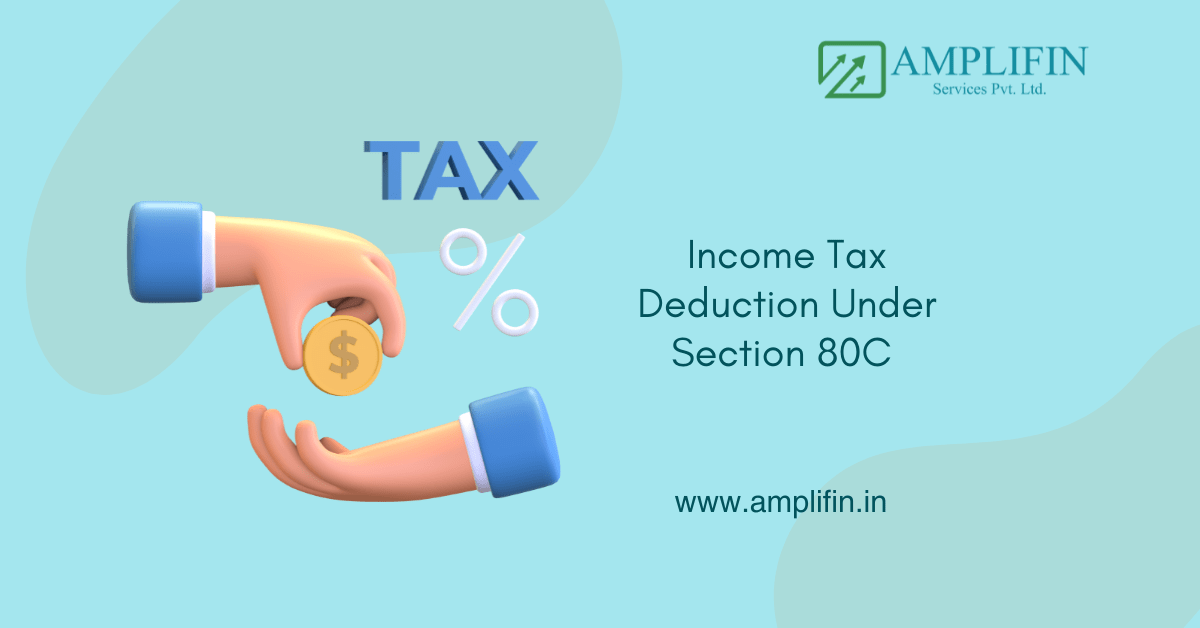What Is Section 80C In Income Tax : Income Tax Deduction Under Section 80C
Are you looking to reduce your tax burden and make your money work smarter? Understanding Section 80C of the Income Tax Act is your key to achieving these goals. This comprehensive guide will walk you through everything you need to know about income tax deductions under Section 80C, helping you maximize your tax savings and invest wisely.

Understanding the Basics of Section 80C
Section 80C is a crucial provision in the Indian Income Tax Act that allows taxpayers to claim deductions on certain investments and expenses. This deduction directly reduces your taxable income, potentially lowering your overall tax liability and increasing your eligible for tax exemptions. The maximum deduction available under Section 80C is Rs. 1.5 lakh per financial year, making it a significant opportunity for tax savings.
Who can benefit from Section 80C? The answer is quite inclusive. Whether you’re a salaried professional, a business owner, or even a Non-Resident Indian (NRI), Section 80C is accessible to you. This wide applicability makes it a crucial component of tax planning for a diverse range of individuals.
Eligible Investments and Expenses Under Section 80C Income Tax Act
Section 80C covers a wide range of investments and expenses, catering to various financial goals and risk appetites. Let’s explore some of the most popular options:
Life Insurance Premiums: Securing Your Future While Saving Tax
Life insurance is not just about financial protection; it’s also an excellent way to save tax. The premiums paid towards life insurance policies are eligible for deduction under Section 80C. Here are some key points to remember:
- For policies issued before April 1, 2012, the entire premium amount is deductible.
- For policies issued after April 1, 2012, the deduction is limited to 10% of the sum assured or actual premium paid, whichever is lower.
- Term insurance plans often offer higher life cover at lower premiums, potentially allowing you to maximize your tax savings while securing substantial life cover.
Public Provident Fund (PPF): A Government-Backed Tax-Saving Option
The Public Provident Fund (PPF) is a popular long-term savings scheme backed by the Government of India, and it is eligible for tax exemption under Section 80C of the Income Tax Act. It offers several advantages:
- Guaranteed returns (interest rates are revised quarterly)
- Long-term wealth creation (15-year tenure with extension option)
- Partial withdrawal facility after the 7th year, which may be eligible for tax exemption under certain conditions.
- Loan facility available from the 3rd year to the 6th year
- Tax-free interest earnings
Employee Provident Fund (EPF): Mandatory Savings with Tax Benefits
For salaried individuals, contributions to the Employee Provident Fund (EPF) are an excellent way to claim Section 80C deductions. Key features include:
- Mandatory for employees in organizations with 20 or more employees
- Employer matches employee contributions
- Interest earned is tax-free
- Option to make voluntary contributions through Voluntary Provident Fund (VPF)
Equity Linked Savings Scheme (ELSS): Tax-Saving Mutual Funds
For those comfortable with some market risk, Equity Linked Savings Schemes (ELSS) offer an excellent opportunity to invest in the stock market while claiming tax deductions. ELSS are mutual funds that primarily invest in equities and have a mandatory lock-in period of three years. Benefits include:
- Potential for higher returns compared to traditional tax-saving instruments
- Shortest lock-in period among all Section 80C options
- Option to invest via Systematic Investment Plans (SIPs) for better rupee cost averaging
National Savings Certificate (NSC): Fixed Returns with Tax Advantages
The National Savings Certificate (NSC) is a fixed-income investment option offered by the Indian Post Office, and it is included in the deduction list under Section 80C. Key features include:
- Fixed interest rate for the entire tenure
- 5-year lock-in period
- Interest accrued is deemed to be reinvested and qualifies for deduction under Section 80C
- Suitable for investors looking for guaranteed returns with moderate liquidity
Sukanya Samriddhi Yojana: Investing in Your Girl Child’s Future
The Sukanya Samriddhi Yojana is a government-backed savings scheme specifically designed for the girl child, and it is eligible for tax exemption under Section 80C. It offers:
- Higher interest rates compared to many other fixed-income options
- Tax-free returns
- Long-term investment horizon (maturity at 21 years of age)
- Partial withdrawal allowed for higher education expenses
Senior Citizens’ Savings Scheme: Tax Benefits for the Elderly
For individuals above 60 years of age, the Senior Citizen Savings Scheme offers an excellent opportunity to earn regular income while availing tax benefits, including additional deductions. Features include:
- Higher interest rates compared to regular savings accounts
- Quarterly interest payout
- 5-year tenure with an option to extend for 3 more years
- Maximum investment limit of Rs. 15 lakhs
Tax-Saving Fixed Deposits: Bank Investments with Deduction Benefits
Many banks offer special fixed deposits with a 5-year lock-in period that qualify for deduction under Section 80C. These tax-saving FDs provide:
- Guaranteed returns
- Option to receive interest payouts or reinvest
- Suitable for risk-averse investors
Home Loan Principal Repayment: Combining Property Investment with Tax Savings
If you’ve taken a home loan, the principal repayment amount is eligible for deduction under Section 80C. This allows you to claim tax benefits on an expense you’re already incurring. Points to note:
- Only the principal component of your EMI qualifies for deduction
- The property should not be sold within 5 years of possession
- This deduction is in addition to the interest payment deduction available under Section 24
Tuition Fees for Children’s Education: Tax Benefits for Parents
Parents can claim deductions under Section 80C for tuition fees paid for their children’s education. Key points to remember:
- Applicable for full-time education in India
- Limited to two children
- Covers only tuition fees, not donations, development fees, or other charges
Strategies for Maximizing Your Section 80C Benefits
To make the most of Section 80C deductions, consider the following strategies:
- Start early in the financial year to avoid last-minute rush
- Diversify your investments across different 80C options
- Consider your risk appetite and investment horizon
- Don’t ignore existing commitments like life insurance premiums and EPF contributions
- Utilize additional sections like 80CCC and 80CCD for extra tax benefits
- Consult with tax experts or financial advisors for personalized strategies
Remember, the key is to align your tax-saving investments with your overall financial goals.
Common Mistakes to Avoid When Claiming Section 80C Deductions
- Exceeding the Rs. 1.5 lakh limit: Any investment beyond this limit doesn’t provide additional tax benefits under Section 80C.
- Ignoring existing deductions: Don’t overlook deductions you’re already eligible for, like EPF contributions.
- Investing solely for tax savings: Consider the overall returns and alignment with your financial goals.
- Last-minute investments: Rushing to invest at the end of the financial year can lead to poor decisions.
- Not keeping proper documentation: Maintain all relevant documents to support your deduction claims and to ensure they are on the deduction list.
How to Claim Section 80C Deductions While Filing Your Income Tax Return
When filing your Income Tax Return (ITR), follow these steps to claim your Section 80C deductions:
- Gather all relevant documents and proofs of investments/expenses.
- Choose the appropriate ITR form based on your income sources.
- In the “Deductions and Taxable Total Income” section, enter the total amount of Section 80C deductions (up to Rs. 1.5 lakh).
- Ensure that you’ve mentioned all eligible deductions.
- Double-check all entries before submitting your ITR to ensure you can claim a deduction accurately.
The Impact of Section 80C Deductions on Your Tax Liability
To understand the impact of Section 80C deductions, let’s consider an example:
Suppose your taxable income is Rs. 8,00,000 per annum. Without any Section 80C deductions, your tax liability (excluding cess) would be:
- Up to Rs. 2,50,000: Nil
- Rs. 2,50,001 to Rs. 5,00,000: Rs. 12,500
- Rs. 5,00,001 to Rs. 8,00,000: Rs. 60,000
- Total: Rs. 72,500
Now, if you claim the full Section 80C deduction of Rs. 1,50,000, your taxable income reduces to Rs. 6,50,000. Your new tax liability would be:
- Up to Rs. 2,50,000: Nil
- Rs. 2,50,001 to Rs. 5,00,000: Rs. 12,500
- Rs. 5,00,001 to Rs. 6,50,000: Rs. 30,000
- Total: Rs. 42,500
In this example, by fully utilizing Section 80C deductions, you save Rs. 30,000 in taxes.
Section 80C vs. Other Tax-Saving Sections: Understanding the Differences
While Section 80C is the most well-known tax-saving provision, it’s important to understand how it relates to other sections:
- Section 80CCC: Covers contributions to certain pension funds
- Section 80CCD: Deals with contributions to the National Pension System
- Section 80D: Allows deductions for health insurance premiums
- Section 24: Provides deductions on home loan interest
These sections, when used in conjunction with Section 80C, can help you maximize your overall tax savings.
The Future of Section 80C: Potential Changes and What They Mean for Taxpayers
The landscape of tax deductions is always evolving. Some potential changes that have been discussed include:
- Increasing the overall limit of Section 80C deductions
- Introducing separate limits for different types of investments, which could influence the deduction list under Section 80C.
- Simplifying the tax structure with fewer deductions but lower tax rates
Stay informed about any changes to ensure you’re always making the most of available tax benefits.
Conclusion: Making Section 80C Work for You
Section 80C offers a valuable opportunity to reduce your tax liability while promoting savings and investments. By understanding the various options available and aligning them with your financial goals, you can make the most of these deductions. Remember to:
- Start your tax planning early in the financial year
- Diversify your investments across different Section 80C options
- Consider your risk appetite and investment horizon
- Stay informed about any changes in tax laws
- Consult with financial advisors or tax experts for personalized advice
With careful planning and smart investment choices, Section 80C can be a powerful tool in your overall financial strategy, helping you save tax and build wealth for the future.
Key Takeaways:
- Section 80C offers a maximum deduction of Rs. 1.5 lakh per financial year
- Diverse investment options are available, catering to different risk appetites and financial goals
- Life insurance, provident funds, and ELSS are popular choices for tax-saving and are included in the deduction list.
- Government-backed schemes like PPF, NSC, and Sukanya Samriddhi Yojana offer security with tax benefits
- Senior citizens have special tax-saving options
- Home loan principal repayment can be claimed under Section 80C
- Additional sections like 80CCC and 80CCD can help maximize overall tax savings
- Early planning and diversification are key to effective tax-saving strategies
- Consult with financial experts to create a personalized tax-saving plan
- Remember to consider factors beyond tax benefits when choosing investments
By understanding and strategically using the deductions available under Section 80C and related sections, you can significantly reduce your tax liability while building a strong financial foundation for the future. Start planning early, diversify your investments, and make informed decisions to maximize your tax benefits and achieve your financial goals.
